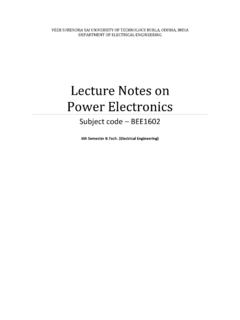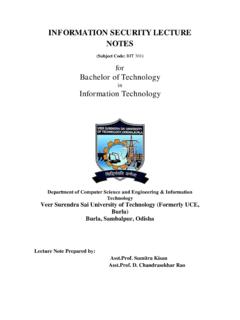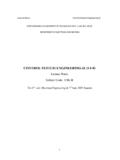Transcription of ELECTRICAL POWER TRANSMISSION AND DISTRIBUTION
1 CLASS NOTES ON ELECTRICAL POWER TRANSMISSION AND DISTRIBUTION A COURSE IN 6TH SEMESTER OF BACHELOR OF TECHNOLOGY PROGRAMME IN ELECTRICAL ENGINEERING (COURSE CODE-BEE605) DEPARTMENT OF ELECTRICAL ENGINEERING VEER SURENDRA SAI UNIVERSITY OF TECHNOLOGY BURLA 2015 2 VEER SURENDRA SAI UNIVERSITY OF TECHNOLOGY, ODISHA, BURLA 3 CLASS NOTES ON ELECTRICAL POWER TRANSMISSION AND DISTRIBUTION DISCLAIMER This document does not claim any originality and cannot be used as a substitute for prescribed textbooks. The matter presented here is prepared by the author for their respective teaching assignments by referring the text books and reference books. Further, this document is not intended to be used for commercial purpose and the committee members are not accountable for any issues, legal or otherwise, arising out of use of this document.
2 4 VEER SURENDRA SAI UNIVERSITY OF TECHNOLOGY, ODISHA, BURLA 5 CLASS NOTES ON ELECTRICAL POWER TRANSMISSION AND DISTRIBUTION FOREWORD BY THE AUTHOR The invention of the electric lamp by Edison in the late 1870s led to rapid expansion in the use of electric POWER . To facilitate the electric POWER has to be generated and transmitted to the consumers via a TRANSMISSION and DISTRIBUTION network. In 1882 the first electric POWER station Pearl street Electric station in New York city went into operation. The original ELECTRICAL DISTRIBUTION system developed by Thomas Edison was an underground direct current (DC) system. This was followed by first ac TRANSMISSION line by Westinghouse in 1886. Ferranti constructed a 10kV link from Deptford, Kent to New Bond Street in London. From the turn of the century to the late 1920s there had been a gradual increase in machine voltage up to 11kV.
3 In 1928, the first 33kV machine was commissioned. Since then there have gradual change in technology, which has enabled the system to operate at extra high voltage 220kV, 400kVand ultra high voltage of 750kV, 1500kV. Thus the study of TRANSMISSION and DISTRIBUTION has become very fundamental for ELECTRICAL engineering students. After studying this subject, the student shall be able to address and understand the issues related to the TRANSMISSION and DISTRIBUTION . 6 VEER SURENDRA SAI UNIVERSITY OF TECHNOLOGY, ODISHA, BURLA 7 CLASS NOTES ON ELECTRICAL POWER TRANSMISSION AND DISTRIBUTION ELECTRIC POWER TRANSMISSION AND DISTRIBUTION (3-1-0) SYLLABUS MODULE-I (10 HOURS) General Introduction to POWER TRANSMISSION by and overhead lines Lines Constants: Resistance, inductance and capacitance of single and three phase lines with symmetrical and unsymmetrical spacing transposition, charging current, skin effect and proximity effect Performance of TRANSMISSION Lines: Analysis of short, medium and long lines, equivalent circuit, representation of the lines and calculation of TRANSMISSION parameters, use of static or synchronous condensers for improvement of regulation.
4 MODULE-II (10 HOURS) Corona: POWER loss due to corona, practical importance of corona, and inductive interference with neighboring communication lines, use of bundled conductors in TRANSMISSION lines and its advantages Overhead line Insulators: Voltage DISTRIBUTION in suspension type insulators, method of equalizing, voltage DISTRIBUTION , economic use of insulators. Mechanical Design of Overhead TRANSMISSION Line, Sag and stress calculation, tension and sag at erection, effect of ice and wind, vibration dampers Under Ground Cable: Type and construction, grading of cables, capacitance in 3 core cables and dielectric loss MODULE-III (10 HOURS) DISTRIBUTION System; types of distributors and feeders (radial & ring), voltage drop and load calculation for concentrated and distributed loads, Primary and secondary DISTRIBUTION network, Capacitor placement in DISTRIBUTION network, DISTRIBUTION system planning, Service area calculation.
5 MODULE-IV (10 HOURS) Substation & Earthing: Types of substations , arrangement of bus-bars and control equipments, solid earthing, resistance earthing and Peterson coil Per unit system one line diagram POWER flow through TRANSMISSION line, POWER circle diagram, Series and shunt compensation. Introduction to Flexible AC TRANSMISSION System (FACTS), SVC, TCSC, SSSC, STATCOM and UPFC BOOKS [1]. John J Grainger, W. D. Stevenson, POWER System Analysis , TMH Publication 8 VEER SURENDRA SAI UNIVERSITY OF TECHNOLOGY, ODISHA, BURLA [2]. I. J. Nagrath & D. P. Kothari, POWER System Analysis , TMH Publication 9 CLASS NOTES ON ELECTRICAL POWER TRANSMISSION AND DISTRIBUTION CHAPTER-1 TRANSMISSION LINE PARAMETERS-I INTRODUCTION The TRANSMISSION line performance is based on its ELECTRICAL parameters such as resistance, inductance and capacitance.
6 As we know the TRANSMISSION line are used for delivering ELECTRICAL POWER from one end to other end or one node to other node, the path of POWER flow the TRANSMISSION line can be represented as an ELECTRICAL circuit having its parameters connected in a particular pattern. Since the TRANSMISSION line consists of conductors carrying POWER , we need to calculate the resistance, inductance and capacitance of these conductors. RESISTANCE OF TRANSMISSION LINE The resistance of the conductor thus TRANSMISSION line can be determined by ( ). AlR ( ) Where '' is the resistivity of the wire in -m, ''l is the length in meter and ''A is the cross sectional area in m2. When alternating current flows through a conductor, the current density is not uniform over the entire cross section but is somewhat higher at the surface.
7 This is called the skin effect and this makes the ac resistance a little more than the dc resistance. Moreover in a stranded conductor, the length of each strand is more that the length of the composite conductor thus increasing the value of the resistance from that calculated in ( ). INDUCTANCE OF TRANSMISSION LINE In order to determine the inductance of TRANSMISSION line, we shall first drive expression for the inductance of a solid conductor and it will be extended to a single phase TRANSMISSION line. Then we shall derive expression for inductance of a group of conductors and then extend it to three phase TRANSMISSION line. INDUCTANCE OF SOLID CONDUCTOR The inductance of solid conductor can be determined by calculating the flux linkage due to current flowing and using ( ). 10 VEER SURENDRA SAI UNIVERSITY OF TECHNOLOGY, ODISHA, BURLA IL ( ) Where L is the inductance in Henry, is the flux linkage in Weber-turns and I is the phasor current in Ampere.
8 INDUCTANCE OF SOLID CONDUCTOR DUE TO INTERNAL FLUX Let us consider a solid conductor of radius ''r cm and the current flowing is ''I A as shown in dxxor INTERNAL FLUX LINKAGE OF A ROUND CONDUCTOR. As we know Ampere's law states that the magnetomotive force (mmf) in ampere-turns around a closed path is equal to the net current in amperes enclosed by the path. Mathematically is written as ( ). IdsHmmf ( ) Where H is the magnetic field intensity in At/m, s is the distance along the path in meter. Let us consider a tubular element of thickness ''dx of the conductor at a distance ''x from the center of the conductor and the field intensity as ''xH at ''x. It is constant at all points that are at a distance ''x from the center of the conductor. Therefore ''xH is constant over the concentric circular path with a radius of ''x and is tangent to it.
9 Let the current enclosed by this path is ''xI. Hence by ( ) we can write as follows. xxxxIxHIdxH 2 ( ) xIHxx 2 ( ) Assuming the current density to be uniform thorugh out the cross section of the conductor, the current at a radius of ''x is given by ( ) 11 CLASS NOTES ON ELECTRICAL POWER TRANSMISSION AND DISTRIBUTION IrxIx2222 ( ) Substituting ( ) in ( ) we get IrxHx22 ( ) The flux density at a distance of ''x is given by xrxxHHB 0 ( ) Considering the unit length of the conductor one metre, the flux in the tubular element of thickness ''dx of the conductor can be given by ( ). dxBdxx ( ) Combining ( ), ( ) and ( ) xdxrIdx22 ( ) The flux linkage at ''x can be given by dxxrIdrxdxx34222 ( ) The total internal flux linkage can be obtained by integrating ( ) over the range of ''x , , from '0' to ''r as follows.
10 RrxdxxrId03402 ( ) 8I ( ) For relative permeability to be 1 r we have 7010 X 4 , hence ( ) can be written as follows, which is the flux linkage due to internal flux. 7int10 X 2 I Wb-T/m ( ) Hence the inductance of the conductor due to internal flux is obtained by using ( ) and ( ). 7intint10 X 21 IL H/m ( ) 12 VEER SURENDRA SAI UNIVERSITY OF TECHNOLOGY, ODISHA, BURLA INDUCTANCE OF SOLID CONDUCTOR DUE TO EXTERNAL FLUX Now we shall calculate the inductance of solid conductor due to flux linking with the conductor externally. Let us consider two points ''&''21 PPat a distance of ''&''21DD from the center of the conductor and external to it. Let us consider a tubular element of thickness ''dx of the conductor at a distance ''x from the center of the conductor and the field intensity as ''xH at ''x.











